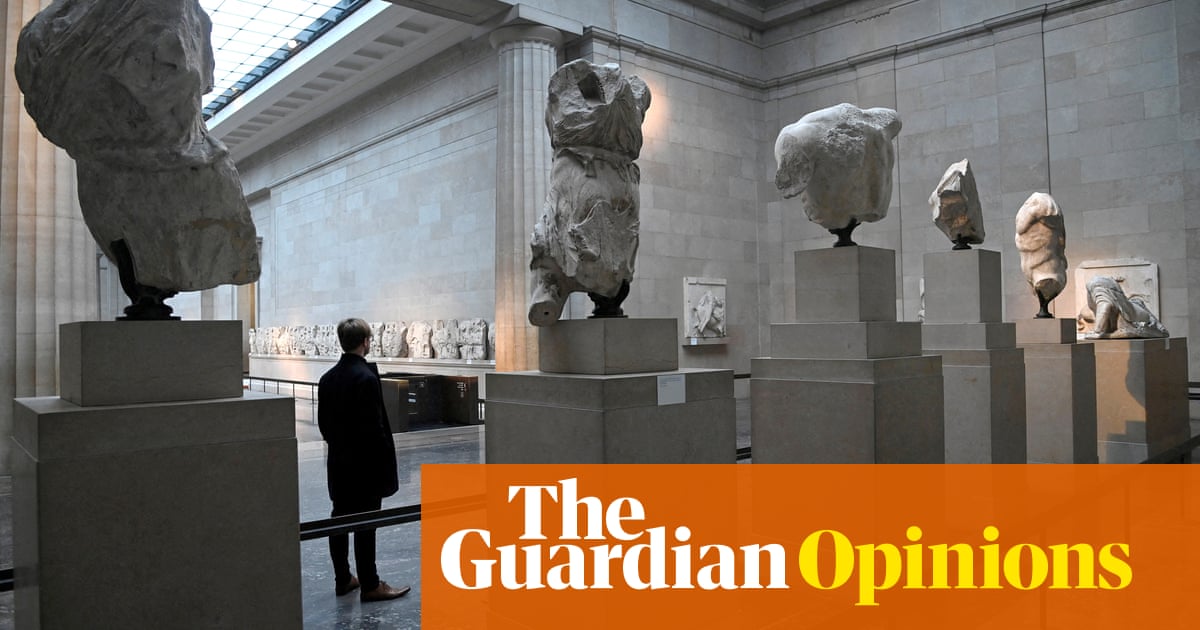
Ican’t help thinking of the title of that old David Lodge novel, The British Museum is Falling Down. The much-beloved institution is teetering beneath the weight of scandal. The museum’s chair has been forced to admit that as many as 2,000 objects have gone missing from the collection over the past decade. Public attention has turned towards an ex-curator allegedly removed from his post last year (his son has said he has done no wrong).
The director of the museum, Hartwig Fischer, has resigned with immediate effect. His deputy, Jonathan Williams, has stepped aside pending an independent review. An antiques dealer-turned-whistleblower has given angry interviews about the museum’s apparent complacency when he alerted managers to the fact that items he had seen listed on eBay seemed to have originated from the BM’s collection. A police investigation is under way.
Inside the museum, the mood is despairing, in an institution in which morale, even before this scandal, was often desperately low. Researchers have been turning their skills towards painstakingly tracking down and recovering missing objects apparently sold on the auction site.
Outside, a storm rages. In a state of chaos, the museum has opened itself up to a barrage of fury from both sides of the political divide both in the UK, and internationally. In Beijing, a state-backed newspaper is demanding the return of Chinese artefacts; there have been calls from everywhere from Athens to north Wales to repatriate objects.
Since the museum can’t keep hold of its own collection, it shouldn’t be allowed to be a custodian of anything at all, runs the argument. Some would go further, and say that the museum is institutionally steeped in theft: since large parts of its collection were wrongfully obtained under colonial conditions, why should anyone be surprised if its modern keepers also turned out to be thieves?
From the right, though, comes another warcry: the museum had one job to do – keep its objects safe – and it failed to do it, because it was too busy worrying about Black Lives Matter and apologising for slavery. According to the Mail, the alleged thefts at the museum are – somehow – the direct result of the fact that those in positions of influence “hate and despise our past”.
Is much of the press and external reaction to do with passionate care for the missing artefacts? Resoundingly, no. It is depressing, and fascinating, to see such ire roused in the breasts of so many about objects to which, I am willing to bet, most of the fulminators have never given a second thought. The media outrage is barely about the objects at all. Rather, the British Museum has – through undeniable institutional failings – put itself in a position that will be depressingly familiar to other large cultural institutions, such as the BBC and the National Trust. It has become a stand-in for the culture wars, a proxy in a battlefield on which it will suffer many wounds before this scandal is resolved.
But let’s think about the idea of care for a moment. The word “curator” – from the Latin meaning a person who takes charge of or undertakes the care of something – has in recent years undergone a rapid shift in meaning. In 2023, everything is curated, from music festivals and magazines (farewell, “programmers” and “editors”) to lipstick ranges and wine lists. The word is understood as projecting an amorphous aura of cool – hence, for example, the bizarre fact that there is even a bar called The Curator at Heathrow airport.
As it happens, it is over more or less the same time period that the actual, real job of museum curator has been cheerfully ground beneath the stiletto heel of the Tory government, with little protest from wider society. Museum curators and researchers – along with registrars, the unsung museum workers responsible for organising and tracking the movement of objects, especially loans – have borne endless Tory cuts. At the British Museum, flat funding from the Conservatives has meant a real-terms cut in revenue grant-in-aid of 37% between 2009-10, under Labour, and now, under the Tories.
As a result of these cuts, there are fewer and fewer curators in the British Museum, with more and more work to do. The institution has been much criticised for having an inadequate catalogue, which could have eased the way for a criminal discreetly to pilfer items from the collection. But the idea that it is somehow easy or quick to undertake the archival work of studying centuries-old acquisition inventories to create a fully modernised museum catalogue and digital database of 8m objects is pure fantasy. Such work requires huge resources – but it needs to be done. Transparency and accuracy should be the bedrock of the museum’s public accountability.
None of this is to excuse the alleged thefts from the museum, nor the apparent institutional blindness that seems to have delayed swift and vigorous investigation of missing objects. Those dark and disturbing occasions when curators steal from collections – consider the case of Anders Burius, a senior librarian who stole numerous volumes from his employer, the National Library of Sweden – constitute the ultimate betrayal of trust.
This kind of destructive, selfish betrayal is exceptionally rare. The British Museum curators I have encountered in the course of my work – who do not include the man who has been named in connection with the alleged thefts – have been among the most diligent, generous and committed public servants I have ever met. They are also paid shockingly little given the qualifications and skills required for the work at the country’s most celebrated museum. (A highly specialised job as a curator focused on Roman-period Egypt, for example, is currently advertised at £32,000.) The case of alleged thefts is a terrible blow for those working on the ground in the museum, and the cause of fury and disbelief. And yet, no one seems to care very much for the curators, as the media become ever more frenzied, and the culture warriors sharpen their swords.
The ultimate irony, the elephant in the room? The chair of this foundering museum is George Osborne, the ex-chancellor of the exchequer, now multimillionaire fund manager. When he took a job at BlackRock in 2017, he was paid a day-rate of £13,000 – yes, earning in three days more than that new British Museum curator will make in a year. As chancellor he was behind the “austerity” cuts to public services and cultural organisations of 2010 onwards. That was not a theft. What it was was a withholding – on a grand and unforgivable scale – of care.
Charlotte Higgins is the Guardian’s chief culture writer












